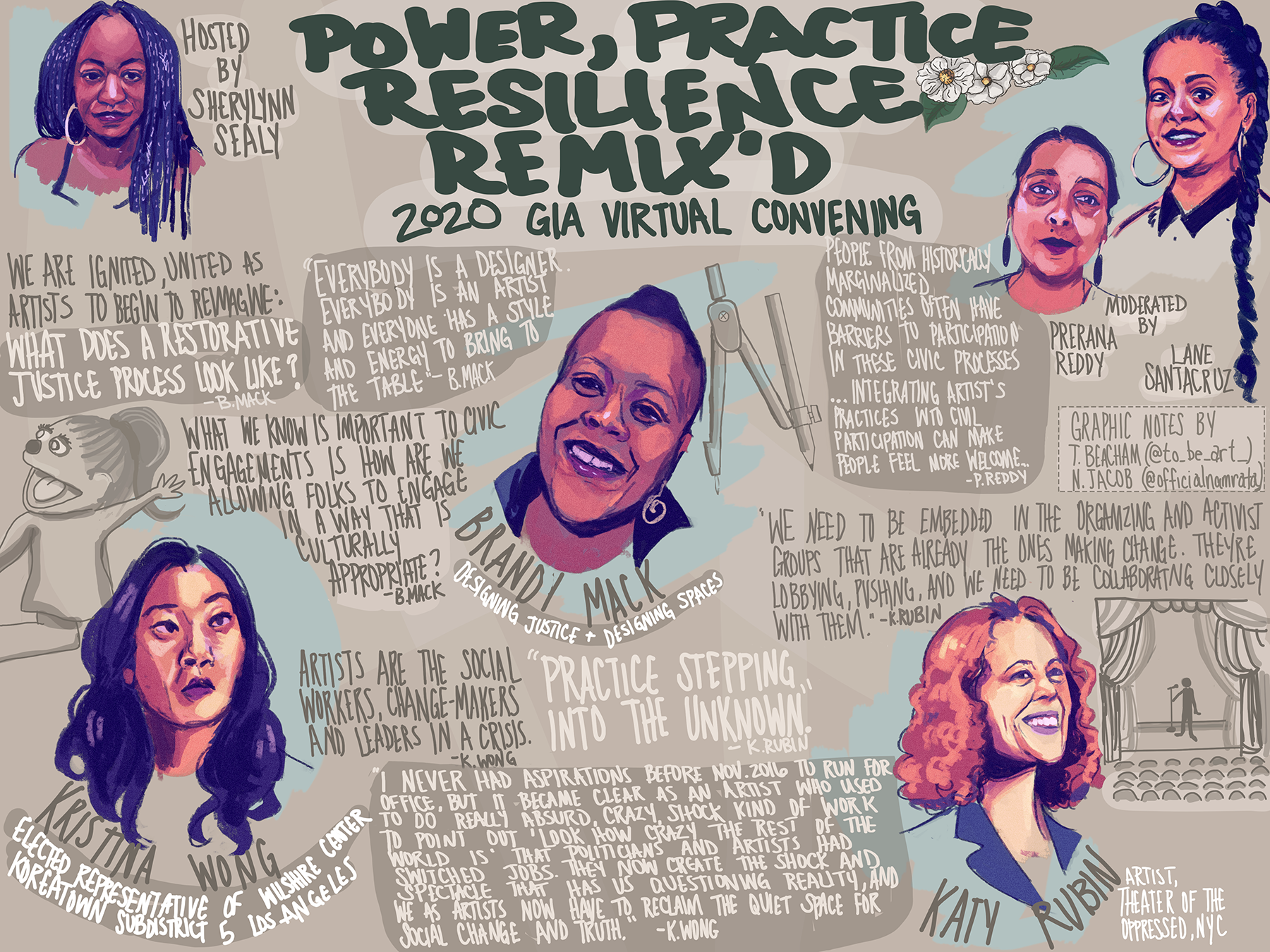Creative Practice as Civic Practice: Supporting artist power in community-led transformation
Friday’s workshop, Creative Practice as Civic Practice: Supporting artist power in community-led transformation, reminded me of what a longtime friend and mentor of mine likes to say: “Community organizing is both an art and a science.”
After this workshop, I’m contemplating the possibilities of artists as community organizers and political leaders. It may have been captured best by Kristina Wong, the comedian and performance artist who is also a newly minted elected official in LA’s Wilshire Center Koreatown neighborhood council. Speaking in front of her Four Seasons Total Landscaping zoom background, Kristina pointed out that, “Politicians and artists have switched jobs. They create spectacles and now artists need to create solutions.”

Conversation from the Creative Practice as Civic Practice: Supporting artist power in community-led transformation workshop, illustrated by Toya Beacham (IG:@to_be_art_) and Namrata Jacob (IG: @officialnamrata), captures the depth of our exploration into the power of artists as political leaders and community organizers.
Wong turned her campaign for office into performance theater, holding a debate with her dog and plagiarizing speeches from dictators, among other antics satirizing the political process. Once elected, she also described hosting an “open mic of undocumented immigrants” to catalyze one of the neighborhood council’s most emotional decisions to support abolishing ICE. Another out-of-the-box endeavor inspired by the pandemic was her founding of a “remote sweatshop” of volunteers to sew free masks in solidarity with communities that need them—the Auntie Sewing Squad (ASS). I have to say, this combination of hilarious and heartwarming can only really be appreciated by those of us with Asian moms and aunties at home right this minute sewing masks for all their relatives.
Wong’s message to funders is that, “Artists are problem solvers who can do a lot with little. My stage is now public office, mutual aid, online platforms, drive-throughs.”
As inspiring and exciting as this was to hear about, it wasn’t entirely unexpected for me to see the connection between artists and the political process. The bigger stretch was to see how the arts can actually create and drive the process for policy development, which was the possibility offered by Katy Rubin’s presentation on the Theatre of the Oppressed NYC’s Legislative Theatre.
Through a process that looked to be part collective playwriting, acting, community planning and townhall, participants gather and identify a problem in an institution due to structural oppression. They use games, exercises, and personal storytelling to build a play centering their experiences with this institution. The play is performed with an interactive audience of peers, stakeholders, and decisionmakers who all participate in a dynamic creative process of coming up with solutions, pushback, and actual writing of policy and practice changes. As someone who literally has to work right now on an umpteenth “community engagement process” where the same community-based organizations are likely to be invited to the same style of meetings (now on zoom) to commit them to the same old task force structure to advise on the same old back and forth between an opaque government process and their communities’ needs…you get the picture…I cannot say enough how these ideas have delighted and challenged me to think out of the box.
Brandi Mack of Designing Justice+Designing Spaces offered powerful examples of the kind of real-world solutions that we can come up with by bringing together the skills of artists, designers, and creatives with community leaders, organizers and advocates. A Mobile Classroom bus, built with engineers and designers in collaboration with re-entering residents to create accessible education resources. A Popup Resource Village in East and West Oakland that provides health and wellness, food and agriculture, arts and culture, retail vendors, and youth resources in disinvested neighborhoods. A Center for Equity where a jail once stood in Atlanta.
Moderator Prerana Reddy summed it up well: “People from historically marginalized communities have barriers to participation in civic processes, and integrating artists can make people feel more welcome, create more joy and interest, safe spaces, and sustain engagement for long processes. We need people willing to shake up systems, within context of working together toward constructive change.”
